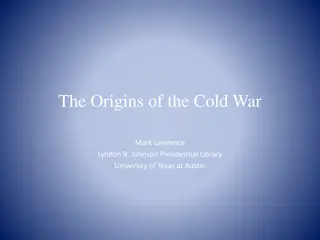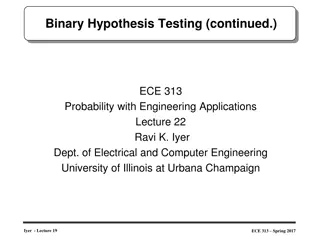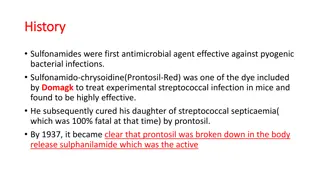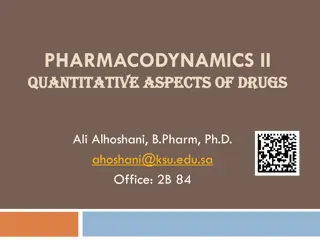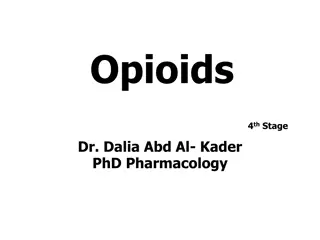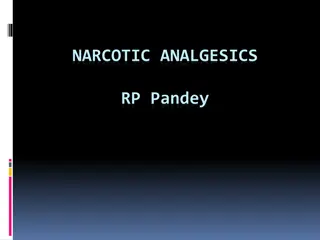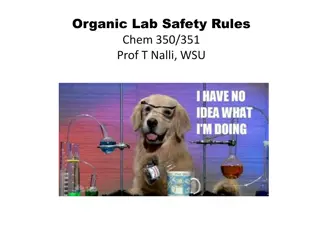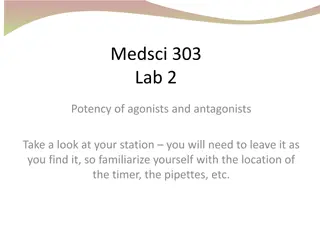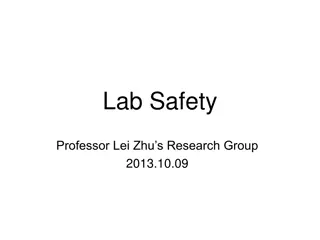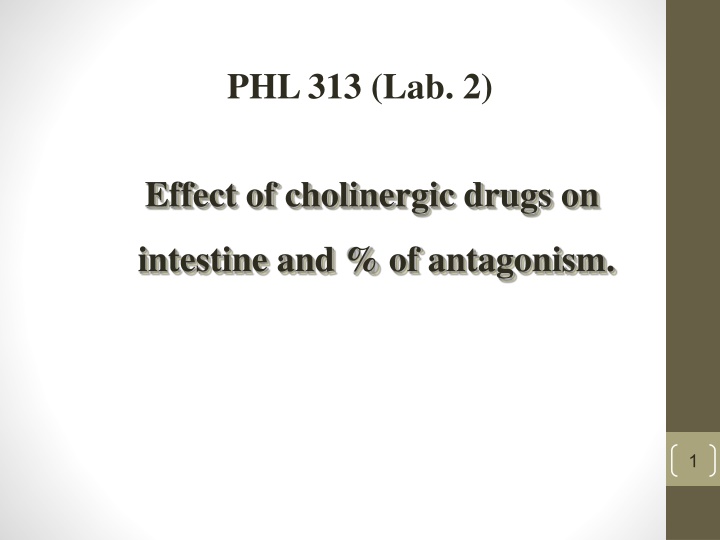
Cholinergic Drugs and Antagonism in Intestinal Effects: Lab Insights
Explore the effects of cholinergic drugs on the intestine, including the actions of cholinergic agonists and antagonists. Learn about muscarinic actions, types of cholinergic agonists, and cholinergic antagonists. Understand depolarization processes and follow a detailed experimental procedure to study the response to different drug interventions.
Uploaded on | 2 Views
Download Presentation

Please find below an Image/Link to download the presentation.
The content on the website is provided AS IS for your information and personal use only. It may not be sold, licensed, or shared on other websites without obtaining consent from the author. If you encounter any issues during the download, it is possible that the publisher has removed the file from their server.
You are allowed to download the files provided on this website for personal or commercial use, subject to the condition that they are used lawfully. All files are the property of their respective owners.
The content on the website is provided AS IS for your information and personal use only. It may not be sold, licensed, or shared on other websites without obtaining consent from the author.
E N D
Presentation Transcript
PHL 313 (Lab. 2) Effect of cholinergic drugs on intestine and % of antagonism. 1
The Muscarinic Actions -- Similar to those of parasympathetic stimulation (M1): CNS, PNS, gastric parietal cells (M2): conducting tissue (M3): exocrine glands; smooth muscle 3
Cholinergics agonist Cholinergic agonists (direct acting ) Acetylcholine Bethanechol Pilocarpine Carbachol Anticholinesterases (indirect acting ) reversible : Neostigmine, physostigmine, pyridostigmine Irreversible : (e.g Organophosphates ) (isoflurophate, echothiophate ) 5
Cholinergic Antagonists [Anticholinergic Agents] Block the actions of acetylcholine at muscarinic or nicotinic cholinoceptors. Cholinergic antagonists competitively inhibit the activity of endogenous Ach. Antimuscarinic agents:inhibit muscarinic receptor-mediated responses. Atropine Scopolamine Ipratropium Ganglionic-blocking agents:inhibit nicotinic receptor-mediated responses at the ganglia. Hexamethonium Pentamethonium Neuromuscular-blocking agents:inhibit nicotinic receptor-mediated responses at the neuromuscular junction. 1. 2. Non-depolarizing : D-tubocurarine Depolarizing : suxamethonium 6
Depolarization 1- Resting potential: In order to maintain the cell membrane potential, cells keep a low concentration of sodium ions and high levels of potassium ions within the cell (intracellular). The sodium-potassium pump moves 3 sodium ions out and moves 2 potassium ions in, thus in total removing one positive charge carrier from the intracellular space. 2- Depolarization is a positive-going change in a cell's membrane potential, making it more positive, or less negative. In neurons and some other cells, a large enough depolarization may result in an action potential. 3- Hyperpolarization is the opposite of depolarization, and inhibits the rise of an action potential. 7
Procedure:- 1- Add 0.2 ml Nicotine and record the response within 10 seconds then wash. 2- Add 0.2 ml C6 wait 2 minutes and add 0.2 ml Nicotine and record the response within 10 seconds then wash. 3- Add 0.2 ml Ach and record the response within 10 seconds then wash. 4- Add 0.2 ml atropine wait 2 minutes and add 0.2 ml Ach and record the response within 10 seconds then wash. 5- Add 0.2 ml BaCl2 and record the response within 10 seconds then wash. 6- Add 0.2 ml C6 wait 2 minutes and add 0.2 ml BaCl2 and record the response within 10 seconds then wash. 7- Add 0.2 ml atropine wait 2 minutes and add 0.2 ml BaCl2 and record the response within 10 seconds then wash. 8- Print the figures and calculate the % of antagonism with agonist (4 equations).
Effect Of Nicotine & Hexamethonium % of antagonist X1 X2 * 100 X1 X1 Wash No Wash x2 9 Hexamethonium (C6) Dil. Nicotine Dil. Nicotine
Effect Of Ach & Atropine % of antagonist X1 X2 * 100 X1 X1 Wash No Wash x2 10 Atropine Ach Ach
Effect Of Bacl2 & Atropine % of antagonist X1 X2 * 100 X1 X1 x2 x2 No Wash Wash Wash No Wash Bacl2 Atropine Hexamethonium (C6) Bacl2 11 Bacl2
Chemicals 1- Tyroid solution 2- Ach (0.01%) 3- Dilute Nicotine (0.01%) 4- Hexamethonium (C6) (0.1%) 5- Atropine (0.1%) 6- Barium Chloride (3%)



